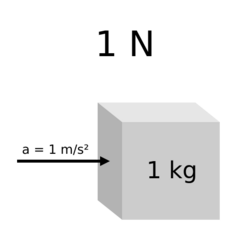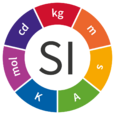Newton (unit)
 From HandWiki - Reading time: 6 min
From HandWiki - Reading time: 6 min
| newton | |
|---|---|
 Visualization of one newton of force | |
| General information | |
| Unit system | SI |
| Unit of | force |
| Symbol | N |
| Named after | Sir Isaac Newton |
| Conversions | |
| 1 N in ... | ... is equal to ... |
| SI base units | 1 kg⋅m⋅s−2 |
| CGS units | 105 dyn |
| Imperial units | 0.224809 lbf |
The newton (symbol: N) is the unit of force in the International System of Units (SI). It is defined as [math]\displaystyle{ 1\ \text{kg}\cdot \text{m/s}^2 }[/math], the force which gives a mass of 1 kilogram an acceleration of 1 metre per second per second. It is named after Isaac Newton in recognition of his work on classical mechanics, specifically his second law of motion.
Definition
A newton is defined as [math]\displaystyle{ \mathrm{1\ kg {\cdot} m/s^2} }[/math] (it is a named derived unit defined in terms of the SI base units).[1]:137 One newton is, therefore, the force needed to accelerate one kilogram of mass at the rate of one metre per second squared in the direction of the applied force.[2]
The units "metre per second squared" can be understood as measuring a rate of change in velocity per unit of time, i.e. an increase in velocity by 1 metre per second every second.[2]
In 1946, the Conférence Générale des Poids et Mesures (CGPM) Resolution 2 standardized the unit of force in the MKS system of units to be the amount needed to accelerate 1 kilogram of mass at the rate of 1 metre per second squared. In 1948, the 9th CGPM Resolution 7 adopted the name newton for this force.[3] The MKS system then became the blueprint for today's SI system of units.[4] The newton thus became the standard unit of force in the Système international d'unités (SI), or International System of Units.[3]
The newton is named after Isaac Newton. As with every SI unit named for a person, its symbol starts with an upper case letter (N), but when written in full it follows the rules for capitalisation of a common noun; i.e., "newton" becomes capitalised at the beginning of a sentence and in titles, but is otherwise in lower case.
The connection to Newton comes form Newton's second law of motion, which states that the force exerted on an object is directly proportional to the acceleration hence acquired by that object, thus:[5] [math]\displaystyle{ F = ma, }[/math] where m represents the mass of the object undergoing an acceleration a. When using the SI unit of mass, the kilogram ([math]\displaystyle{ \text{kg} }[/math]), and SI units for distance metre ([math]\displaystyle{ \text{m} }[/math]), and time, second ([math]\displaystyle{ \text{s} }[/math]) we arrive at the SI definition of the netwon: [math]\displaystyle{ \mathrm{1\ kg {\cdot} m/s^2}. }[/math]
Examples
At average gravity on Earth (conventionally, [math]\displaystyle{ g={9.80665}\ \text{m/s}^2 }[/math]), a kilogram mass exerts a force of about 9.8 newtons.
- An average-sized apple at 200 g exerts about two newtons of force at Earth's surface, which we measure as the apple's weight on Earth.
- [math]\displaystyle{ 0.200 \text{ kg} \times 9.80665 \text{ m/s}^2 = 1.961\text { N}. }[/math]
- An average adult exerts a force of about 608 N on Earth.
- [math]\displaystyle{ 62\text { kg} \times 9.80665 \text{ m/s}^2=608\text{ N} }[/math] (where 62 kg is the world average adult mass).[6]
Kilonewtons

Large forces may be expressed in kilonewtons (kN), where 1 kN = 1000 N. For example, the tractive effort of a Class Y steam train locomotive and the thrust of an F100 jet engine are both around 130 kN.
One kilonewton, 1 kN, is equivalent to 102.0 kgf, or about 100 kg of load under Earth gravity.
- [math]\displaystyle{ 1\text{ kN}=102\text{ kg}\times 9.81\text{ m/s}^2 }[/math].
So, for example, a platform that shows it is rated at 321 kilonewtons (72,000 lbf) will safely support a 32,100-kilogram (70,800 lb) load.[citation needed]
Conversion factors
| newton (SI unit) |
dyne | kilogram-force, kilopond |
pound-force | poundal | |
| 1 N | ≡ 1 kg⋅m/s2 | = 105 dyn | ≈ 0.10197 kp | ≈ 0.22481 lbf | ≈ 7.2330 pdl |
| 1 dyn | = 10−5 N | ≡ 1 g⋅cm/s2 | ≈ 1.0197 × 10−6 kp | ≈ 2.2481 × 10−6 lbf | ≈ 7.2330 × 10−5 pdl |
| 1 kp | = 9.80665 N | = 980665 dyn | ≡ gn ⋅ (1 kg) | ≈ 2.2046 lbf | ≈ 70.932 pdl |
| 1 lbf | ≈ 4.448222 N | ≈ 444822 dyn | ≈ 0.45359 kp | ≡ gn ⋅ (1 lb) | ≈ 32.174 pdl |
| 1 pdl | ≈ 0.138255 N | ≈ 13825 dyn | ≈ 0.014098 kp | ≈ 0.031081 lbf | ≡ 1 lb⋅ft/s2 |
| The value of gn as used in the official definition of the kilogram-force is used here for all gravitational units. | |||||
|
Base |
Force | Weight | Mass | |||||||||||
|---|---|---|---|---|---|---|---|---|---|---|---|---|---|---|
| 2nd law of motion | m = F/a | F = W ⋅ a/g | F = m ⋅ a | |||||||||||
| System | BG | GM | EE | M | AE | CGS | MTS | SI | ||||||
| Acceleration (a) | ft/s2 | m/s2 | ft/s2 | m/s2 | ft/s2 | [[Physics:Gal (unit) | Gal}}]] | m/s2 | m/s2 | |||||
| Mass (m) | slug | hyl | pound-mass | kilogram | [[Pound (mass) | pound}}]] | [[Gram | gram}}]] | [[Tonne | tonne}}]] | [[Kilogram | kilogram}}]] | ||
| Force (F), weight (W) |
[[Pound (force) | pound}}]] | kilopond | pound-force | kilopond | [[Poundal | poundal}}]] | [[Physics:Dyne | dyne}}]] | [[Sthène | sthène}}]] | [[Newton (unit) | newton}}]] | |
| Pressure (p) | [[Pounds per square inch | pounds per square inch}}]] | [[Technical atmosphere | technical atmosphere}}]] | [[Pounds per square inch | pounds-force per square inch}}]] | [[Physics:Atmosphere (unit) | atmosphere}}]] | poundals per square foot | [[Physics:Barye | barye}}]] | pieze | [[Pascal (unit) | pascal}}]] |
See also
- Force gauge
- International System of Units (SI)
- Joule, SI unit of energy, 1 newton exerted over a distance of 1 metre
- Kilogram-force, force exerted by Earth's gravity at sea level on one kilogram of mass
- Kip (unit)
- Pascal, SI unit of pressure, 1 newton acting on an area of 1 square metre
- Orders of magnitude (force)
- Pound (force)
- Sthène
- Newton metre, SI unit of torque
References
- ↑ Bureau International des Poids et Mesures (2019) (PDF). The International System of Units (SI) (9 ed.). Bureau International des Poids et Mesures (BIPM). p. 137. https://www.bipm.org/documents/20126/41483022/SI-Brochure-9-EN.pdf/2d2b50bf-f2b4-9661-f402-5f9d66e4b507?version=1.10&download=true. Retrieved 22 September 2021.
- ↑ 2.0 2.1 "Newton | unit of measurement". Encyclopædia Britannica. 17 December 2020. https://www.britannica.com/science/newton-unit-of-measurement.
- ↑ 3.0 3.1 The International System of Units (SI) (1977 ed.). U.S. Department of Commerce, National Bureau of Standards. 1977. pp. 17. ISBN 9282220451. https://books.google.com/books?id=YvZNdSdeCnEC&pg=PA17. Retrieved 15 November 2015.
- ↑ The International System of Units (SI) (NIST Special publication 330, 2019 ed.). Gaithersburg, MD: NIST. 2019. https://nvlpubs.nist.gov/nistpubs/SpecialPublications/NIST.SP.330-2019.pdf. Retrieved 30 November 2019.
- ↑ "Table 3. Coherent derived units in the SI with special names and symbols". The International System of Units (SI). International Bureau of Weights and Measures. 2006. http://www.bipm.org/en/si/si_brochure/chapter2/2-2/table3.html.
- ↑ Walpole, Sarah Catherine; Prieto-Merino, David et al. (18 June 2012). "The weight of nations: an estimation of adult human biomass". BMC Public Health 12 (12): 439. doi:10.1186/1471-2458-12-439. PMID 22709383.
- ↑ Comings, E. W. (1940). "English Engineering Units and Their Dimensions". Industrial & Engineering Chemistry 32 (7): 984–987. doi:10.1021/ie50367a028.
- ↑ Klinkenberg, Adrian (1969). "The American Engineering System of Units and Its Dimensional Constant gc". Industrial & Engineering Chemistry 61 (4): 53–59. doi:10.1021/ie50712a010.
 |
 KSF
KSF
